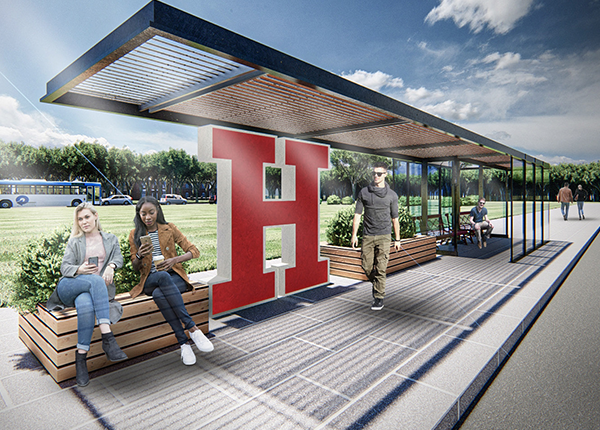
In the spring 2020 semester, University of Hartford architecture students were invited to participate in an exciting design competition to create a new bus stop surround for campus. Five students were recognized for their creative designs. Andrew Petersen ’20, M’21 won first place, Eric Cantar ’21, M’22 and Frank Lonardo ’21 tied for second place, and Wes Moody ’21, M’22 and Brandon Fuentes ’21, M’22 each earned awards of merit. The winning proposals were chosen based on design and related detailing. Student awards included cash prizes and book awards.
The competition was inspired by multiple requests made by students for the University to build a weather break around the existing CT Transit bus stop/shelter on Presidents Way near Bates House. As it currently sits, the bus stop provides only limited shelter to people waiting and does not offer much protection during inclement weather. The requests had a common theme: to add some kind of protection for those waiting in uncomfortable environmental conditions.
Ultimately, the competition was able to be organized as a part of a Parents Fund Grant awarded to Associate Professor of Architecture Ted Sawruk to fund design/build educational experiences for students and to realize a new bus stop for the campus. Through his efforts establishing a partnership with Facilities, it was decided that one of the initiatives would be to improve the existing bus stop on Presidents Way. Department of Architecture faculty saw this as a unique opportunity for students to design potential surrounds and gain real-world experience while taking into consideration the types of constraints that they will face in their careers. The competition also aligned well with many of the values and priorities of the Department of Architecture, National Architectural Accrediting Board, and the greater University, through the opportunity for service learning. With set guidelines established by Facilities, Sawruk and the department launched the completion. The financial awards for the top students were sponsored by the grant funding.
“The competition provided an opportunity for students to design a project, which, although small in scale, required close attention to design constraints and detail,” Department Chair and Associate Professor of Architecture James Fuller explains. “It also demanded students to consider the larger University context in order to design a functional, inviting, buildable, and safe shelter that expresses the character of the University. Competitions such as this one give students a taste of the profession and how architects must balance these same issues of function, expression, and construction in every project.”
The competition was the first of its kind at UHart, held despite the University’s mid-semester transition to distance learning due to the COVID-19 pandemic. Students were expected to practice research, teamwork, hands-on crafting, and integrated structures, and to explore materials and methods of construction through advanced “design development” and construction. Students were also required to submit a proposal in the form of a 24 x 36 vertically oriented sheet that included:
- One “view” of the enclosure surrounding the existing bus stop;
- One dimensional plan showing the existing bus stop, seating, the enclosure, and any proposed lighting or landscaping;
- Additional drawings or renderings at the discretion of the designer.
Brandon Fuentes '21, M'22I chose to participate in the bus stop competition to challenge myself to design outside of the typical building norm and design a functional and aesthetically pleasing bus stop for the University. Throughout the design process, I thought about how the surrounding context could formulate the design by utilizing the proportions of the existing shelter and the materials of the surrounding buildings. This design thinking created a connection between the new bus stop shelter and the surrounding buildings, ultimately incorporating the spirit and identity of the University of Hartford.
Other requirements and considerations for students included:
- The bus stop surround should serve as a University of Hartford physical landmark, while providing a shelter from the weather for the numerous commuter students and the greater University community.
- The enclosure needs to be a self-supported structure, utilizing small-scale metal columns and various weatherproof materials. It will be attached to the existing concrete slab via bolted plates and will surround the existing bus stop structure.
- Materiality should be used to create the character of the surround, including surface, texture, and color.
- Security is a consideration, as the enclosure must provide a level of transparency and cannot create a visually obscure environment.
- The utilization of a prefabricated system is preferred for ease of construction and cost savings; however, individually fabricated proposals can be presented with the related detail drawings.
- Construction or fabrication drawings may be required for the design chosen for implementation.
It was a true team effort to make this competition possible. Five UHart faculty and staff members served as jurors reviewing submitted work and selecting the final winners: Jane Horvath, associate professor of economics; Paula Ribeiro, director of brand strategy in the Office of Marketing and Communication; Tim Garland, assistant director of facilities, academic & auxiliary operations; Timothy Adekunle, assistant professor of architecture, and Duo Dickinson, FAIA, NCARB, Principal of Duo Dickinson Architects, who served as an adjunct faculty member of architecture in the spring 2020 semester.
According to Adekunle, the bus stop design competition was a huge success, with a thorough and rigorous review process. “The panel received many strong design entries from students even though the design competition was held amid the pandemic,” he says. “The selected designs were also functional and well developed.” Dickinson adds there was a “terrific set of approaches to the same problem. The insights that the students put on display showed how a familiar situation offers a fresh opportunity for creative expression.”